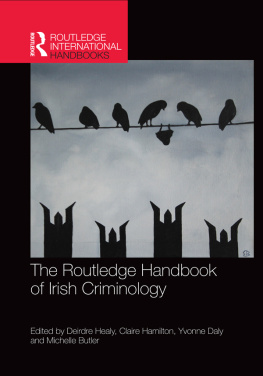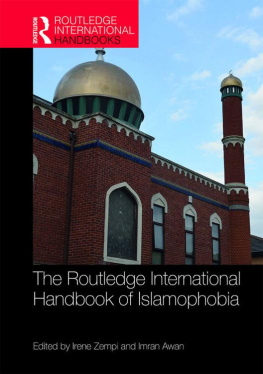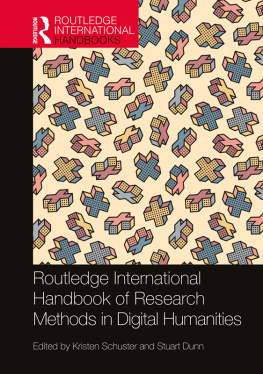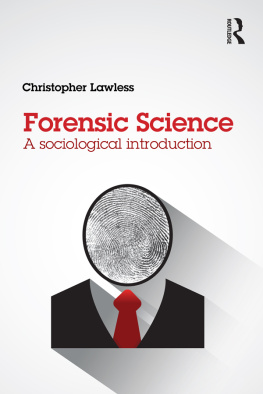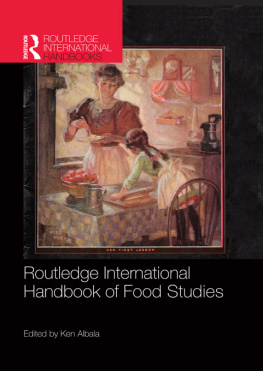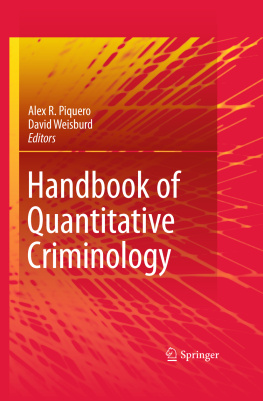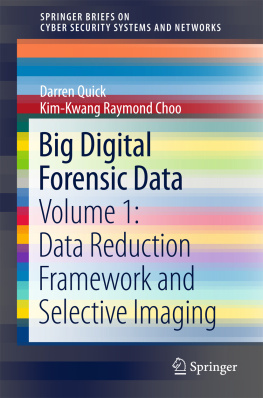
The Routledge International Handbook of Forensic Intelligence and Criminology
Despite a shared focus on crime and its extended family, forensic scientists and criminologists tend to work in isolation rather than sharing the data, methods and knowledge that will broaden the understanding of the criminal phenomenon and its related subjects.
Bringing together perspectives from international experts, this book explores the intersection between criminology and forensic science and considers how knowledge from both fields can contribute to a better understanding of crime and offer new directions in theory and methodology.
This handbook is divided into three parts:
Part I explores the epistemological and historical components of criminology and forensic science, focusing on their scientific and social origins.
Part II considers how collaboration between these disciplines can bring about a better understanding of the organizations and institutions that react to crime, including the court, intelligence, prevention, crime scene investigation and policing.
Part III discusses the phenomena and actors that produce crime, including a reflection on the methodological issues, challenges and rewards regarding the sharing of these two disciplines.
The objective of this handbook is to stimulate a new interdisciplinary take on the study of crime, to show how both forensic and criminological theories and knowledge can be combined to analyse crime problems and to open new methodological perspectives. It will be essential reading for students and researchers engaged with forensic science, criminology, criminal behaviour, criminal investigation, crime analysis and criminal justice.
Quentin Rossy is Assistant Professor at the cole des sciences criminelles Universit de Lausanne, Switzerland.
David Dcary-Htu is Assistant Professor at the cole de criminologie Universit de Montral, Canada.
Olivier Delmont is Full Professor at the cole des sciences criminelles Universit de Lausanne, Switzerland.
Massimiliano Mulone is Associate Professor at the cole de criminologie Universit de Montral, Canada.
The Routledge International Handbook of Forensic Intelligence and Criminology
Edited by Quentin Rossy, David Dcary-Htu, Olivier Delmont and Massimiliano Mulone
First published 2018
by Routledge
2 Park Square, Milton Park, Abingdon, Oxon OX14 4RN
and by Routledge
711 Third Avenue, New York, NY 10017
Routledge is an imprint of the Taylor & Francis Group, an informa business
2018 selection and editorial matter, Quentin Rossy, David Dcary-Htu, Olivier Delmont and Massimiliano Mulone; individual chapters, the contributors
The right of Quentin Rossy, David Dcary-Htu, Olivier Delmont and Massimiliano Mulone to be identified as the authors of the editorial material, and of the authors for their individual chapters, has been asserted in accordance with sections 77 and 78 of the Copyright, Designs and Patents Act 1988.
All rights reserved. No part of this book may be reprinted or reproduced or utilised in any form or by any electronic, mechanical, or other means, now known or hereafter invented, including photocopying and recording, or in any information storage or retrieval system, without permission in writing from the publishers.
Trademark notice: Product or corporate names may be trademarks or registered trademarks, and are used only for identification and explanation without intent to infringe.
The cover picture was made by Rodolphe Archibald Reiss (18751929, founder of the school of Lausanne), near 1911, when he was teaching in St-Petersburg and Moscow. This board was used to train police officers to understand what should be observed during a control to identify specific burglars known as Ceiling drillers. Indeed, in the early years of the 20th century, some offenders went upstairs of the targeted premises, made a small hole in the floor, inserted the umbrella and opened it, they could then enlarge the hole (the debris fell down in the umbrella) and finally they used the ladder to go down to commit the theft. The Russian inscription on the board is The physical evidences collected at the scene of the crime.
Copyright: Archives de lcole des Sciences Criminelles de lUniversit de Lausanne, Suisse.
British Library Cataloguing-in-Publication Data
A catalogue record for this book is available from the British Library
Library of Congress Cataloging-in-Publication Data
Names: Rossy, Quentin, editor.
Title: The Routledge international handbook of forensic intelligence and criminology / edited by Quentin Rossy, [and three others].
Description: Abingdon, Oxon ; NewYork, NY : Routledge, 2018. |
Series: Routledge international handbooks | Includes bibliographical references and index.
Identifiers: LCCN 2017029096| ISBN 9781138688216 (hardback) |
ISBN 9781315541945 (ebook)
Subjects: LCSH: Forensic sciences. | Criminology.
Classification: LCC HV8073 . R7265 2018 | DDC 363.25dc23
LC record available at https://lccn.loc.gov/2017029096
ISBN: 978-1-138-68821-6 (hbk)
ISBN: 978-1-315-54194-5 (ebk)
Typeset in Bembo
by Keystroke, Neville Lodge, Tettenhall, Wolverhampton
Contents
Introduction
Massimiliano Mulone, Quentin Rossy, David Dcary-Htu and Olivier Delmont
PART I
Criminology and forensic science: historical developments and epistemological perspectives
Twin sciences? The history of forensic science and criminology
Paul Knepper
Criminology and forensic science as a Unitas Multiplex: an epistemological approach
Cndido da Agra
Traceology, the bedrock of forensic science and its associated semantics
Pierre Margot
A method that combines criminology and forensic science: considering the case of antiterrorism
Maurice Cusson
A rendezvous between forensic science and criminology: toward a public forensic criminology?
Roberta Julian and Manon Jendly
PART II
Forensic practices and crime regulation
Forensic-led regulation strategies: are they fit for security problem-solving purposes?
Frank Crispino and Claude Roux
Forensic practices and policies
Jan De Kinder
The practice of crime scene examination in an intelligence-based perspective
Olivier Delmont, Sonja Bitzer, Manon Jendly and Olivier Ribaux
Boosting crime scene investigations capabilities through crime script analysis
Benoit Leclerc
The CSI effect
Simon A. Cole and Glenn Porter
Forensic science and wrongful convictions
Jolle Vuille and Christophe Champod
Forensic intelligence
Olivier Ribaux and Stefano Caneppele
Prevention and forensic science: how forensic evidence supports prevention
Nick Tilley and James French
Evaluating the consumption of illicit drugs via wastewater analysis: how forensic indicators are used in open and confined settings
Pierre Esseiva, Lisa Benaglia, Frederic Been and Frank Zobel
PART III
Forensic science and crime analysis
Reconstruction and study of offending trajectories through forensic evidence: an illustration using a forensic DNA database


